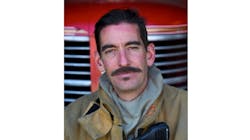Being hired for my first paid firefighter position in 1996 felt like winning the lottery. Not only was I happy for the opportunity to serve the community and to have a job that was filled with excitement, but, more importantly, I was thrilled to experience followership, working for people from whom I could learn true leadership.
Having served in the military, I already had a solid understanding of service. I knew the fire service was built on structure, pride, motivation, ethics and trust, just to name a few important characteristics.
While I was in the military, I learned very strict autocratic leadership. (The military is one of the most structured fields in the world. It must be when you consider that the military is about protection for the entire country as well as for our allies.) Autocratic leadership works well for the military, but I was moving into a career of professional thinking firefighters.
The fire service expects us to be able to not only accept and follow orders but to think for ourselves and be part of a team that’s designed to solve complex problems. Fire department teams are structured to work independently but also to work in multiteam systems. So, when considering ourselves as multidimensional firefighters, it begs the question: What type of leadership style is most effective in the pursuit of our fire department vision?
A vision for today’s leader
After coming out of the military and beginning to work as a sworn firefighter, I quickly noticed a tired feeling in areas of our field. As a new firefighter, I was motivated in many ways. The idea of running calls all night long and of training to the point of exhaustion to learn from those who had the experience was stimulating. I was ready to be tested.
I found that some firefighters who were ahead of me didn’t share the enthusiasm. They didn’t question me on my knowledge or skills. Instead, they watched to see how well I cleaned the bathroom or folded laundry. True, those tasks hold significant importance in becoming a trusted member of the team, but without a new firefighter knowing that, it can be easy for the new firefighter to lose motivation. That can inhibit the new firefighter from asking the right questions and seeking out the right people and finding mentorship.
My vision
Today’s leader has the ability to be someone who is different, someone who is more inspiring. What I have learned about the fire service is that, similar to the military, the autocratic style can create a culture of leading through intimidation and fear. With this style, the top holds all of the power and the bottom follows orders. When applied incorrectly, this doesn’t allow for or promote the thinking firefighter who is required on today’s fireground. It can create firefighters who are afraid to make decisions without the approval from above. At times, this can create extreme micromanagement.
It’s important to state that every generation that came before us created its own culture, which worked for them. Because the fire service, as a whole, is evolving and members are moving up through the ranks, we are seeing a shift in leadership styles, just as previous generations did.
I believe that the current shift in the overall fire service is pushed by the many firefighters who came on after I did. In my organization, this shift is fostered and supported heavily by those who are above me and have experienced a variety of leadership styles. This shared vison from the top down is imperative to the success of positive change.
Across the nation, I see a similar vision for fire department leadership. A major part of this vision relates to two contrasting styles that are much different than the autocratic style that we saw from the generations who came before us.
Servant leadership
In an essay that was published in 1970 by Robert K. Greenleaf, “The Servant as Leader,” Greenleaf wrote, “The servant-leader is servant first.” This steps outside of the idea of the Great Man Theory, which is attributed primarily to Thomas Carlyle and is discussed in Leigh L. Thompson’s “Making the Team: A Guide for Managers.” Greenleaf implies that people have a desire to serve, and this can hold true in a leadership position.
Using servant leadership, a leader's first priority becomes the people they lead. In doing so, leaders must give up the conventional pyramid style, where the leader is at the top and the employees are under their direction.
Essentially, servant leadership can give employees power over the leader. Thus, it challenges leaders to set aside their ego, listen to their employees, and take action for or set the vision of mentoring all employees equally. Servant leaders must value diverse opinions, create trust, think long-term, act with humanity, and develop leaders. A main goal is to empower employees to commit to something outside of their own self-interest. These leaders are resources for their employees and consistently ask the question, “What can I do to help you?”
Transformational leadership
In 1978, while researching political leaders, James MacGregor Burns developed the concept of transformational leadership. His idea was that leaders and followers help each other to gain a higher state of motivation and morale. There is no give and take, similar to a transactional leadership style.
Transformational leadership is about inspiring cultural change within an organization. It allows leaders to set a strong positive example that motivates employees to take greater ownership in their mission, with the belief that this optimizes performance.
When enacted correctly, teams see positive benefits, such as higher expectations, clear organizational vision, positive behaviors, individual support, and stronger organizational culture.
The fire department
When discussing leadership styles, we must consider this: Fire department leaders can be looked at in different roles. They can be leaders in the position of commanding emergency scenes while also providing overall leadership toward the mission, vision and values of the organization. In this article, we only consider the overall leadership aspect, because this is a key area where motivation and morale issues rest.
The mission and leadership
During more than 20 years in the fire service, I have been asked many times what I actually do. Today’s fire service is such a well-rounded and dynamic profession that this question often isn’t easy to answer. A few years ago, I began to answer by simply saying, “We solve people’s problems.”
Today’s 9-1-1 system is used most widely when people have a problem and they don’t know what to do. Essentially, we are a service that assists people when they run out of options. This typically isn’t what people envision when they think of the fire department.
The reality is that’s exactly what most firefighters sign up for. Most of us want to be the ones who put out fires, extricate people who are trapped in vehicles and perform lifesaving measures on someone who has a gunshot wound. However, when we interviewed for this profession, we all said simply that we wanted to serve and be proud of a community.
In our diverse fire departments, we should begin to look at service differently with each promotion that we take. The firefighter ranks are the blue-collar workers of the industry. While at a fire, the firefighters are the ones who do a majority of the manual labor.
The company and chief officers decide strategies and tactics to accomplish the overall goal. This leads me to believe that as officers, we serve the firefighters. We assign the most efficient and effective strategies and tactics to keep the citizens as safe as possible. These strategies and tactics allow firefighters to rescue victims, put out the fire and protect property.
When considering this, it’s our responsibility as fire department leaders to create intrinsic motivation, positive morale, dependability and teamwork. When this relationship is established, there are few limits to what fire department teams can achieve. These relationships build a trust that’s maintained for the length of a career and, often, for a lifetime.
Looking back at my fire service career, in a firehouse setting where the leadership style was autocratic, there was often a lack of morale and motivation. Don’t get me wrong, there still is a time and place for autocratic leadership, such as at emergency scenes, but in a firehouse setting, it doesn’t create a lasting, healthy work environment.
Balance
Previously, I had a personal bias toward servant leadership, but I knew that this doesn’t fit the leadership needs of the fire service all of the time.
We come across many unique situations from day to day, each of which can require a different leadership style to be effective. This makes me believe that, when used correctly, transformational leadership can be a very appropriate approach to fire department leadership.
As I continue to grow and practice leadership in the fire service, my approach will be to apply and teach transformational leadership, while striving to find the balance between this and a strong command presence, as needed.
About the Author

Joshua Winter
Joshua Winter is a 32-year student of the fire service, beginning his studies as a Los Angeles City Fire Explorer. In 1993, he joined the U.S. Army, first as a combat medic, then reclassifying to become an Army firefighter. Winter worked at multinational agencies as a volunteer firefighter in Camp Humphreys, South Korea, and in a paid professional position with a NATO fire department in the Netherlands. In the United States, he has held paid professional positions at Ft. Carson, CO, Fire and Emergency Services; Rocky Mountain Arsenal Fire Department in the National Wildlife Refuge in Colorado; and the U.S. Forest Service. In 2002, Winter began his career with Colorado Springs, CO, Fire Department, where he is assigned to the Training Division as a captain who is responsible for fire officer development.
